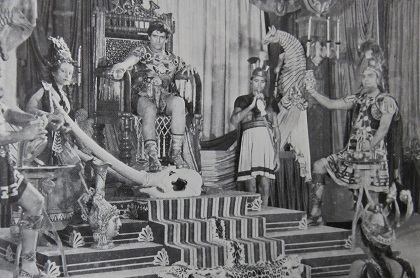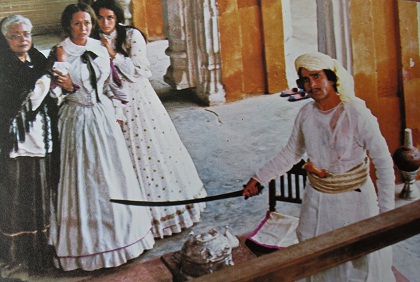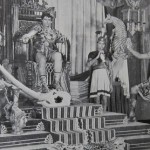This is the final in our two-part series on India-Afghanistan relations. Click here to read the first part.
Large numbers do not always mean power, influence or visibility. Mumbai’s Pathans* (See Part 1 of this series), a small and self-sufficient group dealing principally in dry fruits and saffron, may no longer stand out in the mosaic of communities of which the city is comprised. But one business that continues to give them high visibility is Mumbai’s Hindi film industry. A few names suffice to spell the extent of their superstardom, whether as director, producer, script-writer or actor: Pathan stars of yesteryear, Prithviraj Kapoor and Dilip Kumar (neé Yousuf Khan) remain evergreen in cine buffs’ memory.
The late progenitor, Prithviraj Kapoor, whose illustrious family[1] is still in the movie business, is regarded a ‘Hindu Pathan’ by the film fraternity, but a family member clarifies that they are, in fact, Punjabi Khatris. This overlap in identity is probably due to his origins in undivided India’s Northwest Frontier Province, in the capital city of Peshawar, like his contemporary, the actor Jayant (whose real name was Zakariya Khan) and Dilip Kumar[2]. Today’s reigning trio is Shahrukh-Salman-Aamir Khan, with Salman keeping alive the legacy of father and scriptwriter, Salim Khan, and Aamir that of his father, producer-director Tahir Hussain Khan[3]. Other descendants of past Pathan stalwarts, like brothers Feroz and Sanjay Khan, are the cousins Fardeen and Zayed.

Many reasons account for the Pathans’ enduring success in Hindi films. First, they emerged at the cusp of the transition from silent films to the talkie era in Bombay’s film industry. With the advent of the first talkie film, Alam Ara (1931) from the Imperial Film Company, many of those who acted in the silent movies faded away, making way for a new crop of stars. The Pathans quickly gained an edge in the industry because they were fluent in Urdu and Hindi. (Dilip Kumar has written about how his fluency in Urdu, a language spoken with great flair by his family, led to him being tasked with helping Bombay Talkies studio’s scriptwriters with the finer nuances of the language during his first few months there.[4])
The first popular Pathan actor in the early 1930s was Gul Mohammad, says Salim Khan. But others who made good in Bombay films had earlier tasted success in Lahore’s film industry, says Shehla Khan, wife of the late Pathan actor Amjad Khan, who was memorable as Gabbar Singh, the Chambal dacoit in the blockbuster film, Sholay (1975). Her father-in-law, Jayant, and Prithviraj Kapoor, both Peshawaris, had worked in films being made in Lahore[5], where the lingua franca was Hindko, a dialect that is a mix of Punjabi, Pushto (which was the Pathans’ native tongue), Urdu, and Persian.
The Pathan actor’s diction, in general, is perfect, and emotional range impressive, with an ability to go from restraint to high-pitched histrionics. As a people too, they are highly emotional. “The Pathans cry very easily,” observes Shehla, a Rajput and the first non-Pathan to marry into the actor Jayant’s family. “My father-in-law and Amjad both cried at the drop of a hat. Amjad would return home late from a shoot and see the children sleeping and get emotional. The men cry more than the women; the women are tough.”
Their good looks, machismo, and an appealing “swagger”, (as one interviewee described it,[6]) only added heft to their sensitivity. Shehla clarifies though that not everyone subscribed to the stereotype of the ‘tall, fair Pathan’. “They are also a people used to hard labour, and so they are not all fair-skinned because they largely work outdoors. They also have tremendous loyalty and pride,” she adds.
These characteristics have been portrayed in the numerous Pathan roles and stories scripted for the silver screen.
Pathan movie characters, themes, locales
One of the most memorable Pathan screen characters in Hindi films is that of Sher Khan (played by Pran Sikand), in the film Zanjeer (1973), which was scripted by Salim Khan and Javed Akhtar, a long and award-winning partnership[7]. Sher Khan, a Pathan don, runs a gambling den, but true to his code, does so with honesty. He quits the lucrative business after giving his word to the hero of the film, an upright police officer (played by Amitabh Bachchan), who later becomes his friend. “That character was highly appreciated by the Pathans,” say Salim Khan, “I crafted Sher Khan, based on my observations of my community,” he adds. (Salim Khan belongs to the Akozai tribe and hails from the Swat region, which is today a part of Khyber Pakhtunkhwa Province, Pakistan.) “They are simple people of character and principle, god-fearing, brave, strong, and keep to their commitments.”
The costuming also adds colour to the Sher Khan character, who wears the billowing Pathan kurta-salwar, turban, and gold-embroidered waskat (a short, sleeveless overcoat). The film has a memorable song on loyalty and friendship,‘Yaari Hai Imam Mera/ Yaar Meri Zindagi’ (friendship is my faith/the friend is my life), which is danced to only by men in the traditional Afghan or ‘Ataan’, style with a twirling of rumaals (large handkerchiefs). “Pathan women don’t dance, but the men are exuberant and will get up and dance at the slightest excuse,” Shehla points out.
The mother of all Pathan movies remains Kabuliwala (1961), based on Rabindranath Tagore’s eponymous short story, and in which the legendary actor Balraj Sahni acts as the Afghan peddler who befriends a little girl.[8] [9]

Another milestone was Prithviraj Kapoor’s play, Pathan, (1947), which was produced post-Partition by Prithvi Theatre, and travelled across the length and breadth of India to full houses, says Salim Khan. This play did 600 shows in Bombay itself. Prithviraj played the lead role and his children (Raj, Shammi, Shashi) had small parts.
Kabuliwala and Pathan are the earliest wholly Pathan-themed scripts, made with India as backdrop – undivided and post-Partition, respectively. But the first Hindi film to be shot in Afghanistan was the Feroz Khan-directed[10] Dharmatma (1975), which shows the Afghan sport of Buzkashi on the Indian screen for the first time[11].
This was followed 17 years later by the Amitabh Bachchan-starrer, Khuda Gawah (1992), which was filmed just before the Mujahideen takeover of Kabul and its national government. This film, which used many local Afghans in small roles, made waves as Bachchan and the crew were accorded a presidential welcome: President of Afghanistan Dr. Mohammad Najibullah Ahmadzai, a fan of Bachchan’s, was present at the tarmac to welcome them, the first ever state welcome for a Hindi film crew[12]. President Najibullah’s excitement at meeting Bachchan was an expression of the great love that most Afghans have for Hindi movies and its stars. The last known Hindi film to be shot in Afghanistan, was Kabul Express (2006), whose director Kabir Khan also has Pathan ancestry.
Prior to the coming of fame and fortune, there was the struggle, and Salim Khan recalls the support he received from unknown members of the Pathan community. He had just arrived from Indore as a 23-year-old in 1958[13]. “There were many taxi-drivers in the city and watchmen at the film studios then who were Pathans. Often, when I took a taxi and asked the driver ‘Khan saab, kitna paisa hua’, he would reply, ‘Tum se paisa kaise le sakta! Tum to hamara bhai hai’ (How can I take money from you, you are our brother.) I don’t know how they knew I was Pathan!” Other stars recall having their first brush with the industry when stopped at a studio gate, usually by a tall, imposing Pathan watchman, seeking their credentials.
Since Partition, there has been a steady outward migration of Pathans, both from the city and the industry. Many Pathans, like film director Zia Sarhadi,[14] relocated to the newly formed state of Pakistan.
Yet, many film family scions are carrying on the legacy of their forebears. Where once the early actors assumed screen names, today’s actors wear the Khan surname with panache. Film industry insiders all agree that the name is almost akin to being a marker for blue-blooded acting genes, which was not so in the 1930s and 1940s, when the Khans had just entered the industry. “Anyone from any community can have talent,” says Salim Khan, “It so happens that only the talented Pathans joined the film industry. And they were lucky to be offered good roles, so they became successful.”
The author would like to thank Bharathi S. Pradhan, columnist, critic and author, and Rafique Baghdadi, film historian, for their insights and help.
Sifra Lentin is Bombay History Fellow, Gateway House.
This is the final in our two-part series on India-Afghanistan relations. Click here to read the first part.
This article was exclusively written for Gateway House: Indian Council on Global Relations. You can read more exclusive content here.
For interview requests with the author, or for permission to republish, please contact outreach@gatewayhouse.in
© Copyright 2020 Gateway House: Indian Council on Global Relations. All rights reserved. Any unauthorized copying or reproduction is strictly prohibited.
References
[1] Four generations of Prithviraj Kapoor’s family have enriched Mumbai’s Hindi film industry: his three sons, Raj, Shammi and Shashi, were involved in every aspect of it – from acting, directing and producing to owning studios and theatres. His grandchildren, Randhir, Rishi, and Rajiv, and great-grandchildren, Karishma, Kareena, Ranbir, and Armaan have also made a name.
[2] Many well-known Hindi film actors have their ancestral homes in Peshawar, the most well-known of them being Dilip Kumar, and Prithviraj Kapoor, whose son, Raj, was born, and spent his early childhood, here. Actor Shahrukh Khan (whose father Taj Mohammed Khan is a Peshawari), also has a family home here. All three family havelis are located within a 200-m radius of Qissa Khwani (lit. ‘street of storytellers’) and walking distance from one another. The actor Jayant (Zakariya Khan), father of Amjad and Imtiaz Khan, also hails from Peshawar.
[3] Actor Aamir Khan’s roots can be traced to Herat Province in Afghanistan. He is related to India’s third president, Dr. Zakir Hussain.
[4] Nayar, Udayatara, ‘Dilip Kumar: The Substance And The Shadow, An Autobiography’, Hay House Publishers India Pvt. Ltd., 2014, p. 119-120.
[5] There were many well-known Hindi film actors and actresses, who had their early career in the Lahore film industry. Besides Prithviraj and Jayant, there were brothers Madan and Amrish Puri, and actress Zohra Sehgal.
[6] Rafique Baghdadi, film historian and expert on Saadat Hasan Manto, Hindi movie scriptwriter and writer, was interviewed for this article on 6 January 2020.
[7] Scriptwriters Salim Khan and Javed Akhtar formed their award-winning partnership in 1965, which resulted in 10 back-to-back superhit films, including Seeta Aur Geeta, Haathi Mere Saathi, Zanjeer, Yaadon Ki Baraat, Deewaar, and Sholay. The duo split up in 1981. Prior to scriptwriting, Salim Khan was an actor, doing numerous small roles in Hindi films between 1958 and 1965. (Interview with Salim Khan on 6 January 2020.)
[8] The first film, based on Tagore’s short story, was made in Calcutta by Tapan Sinha in 1957.
[9] Another film with an iconic Pathan character is the Raj Kapoor-directed Chhalia (1960). Set amidst the turmoil of Partition, the Chaplinesque tramp character and small-time conman, acted by Raj Kapoor, encounters Abdur Rahman Khansaheb (a Pathan, played by Pran).
Foschini, Fabrizio, ‘A Pathan Moustache hair’s worth: Afghans in Bollywood, Bollywood in Afghanistan’, Afghanistan Analysts Network, 28 August 2012, https://www.afghanistan-analysts.org/a-pathan-moustache-hairs-worth-afghans-in-bollywood-bollywood-in-afghanistan/ (Accessed on 20 January 2020)
[10] The Khan brothers – Feroz (Zulfikar Ali), Sanjay (Shah Abbas) and Akbar – hail from Bangalore. They trace their roots on their father’s side to the Tanoli tribe from Ghazni.
[11] Buzkashi (lit. “goat grabbing”) is the national sport of Afghanistan. Players, mounted on horses, attempt to place the carcass of a goat or calf in a goal. Similar games – kokpar, kupkari, and ulak tartysh – are played in Kyrgyzstan and Kazakhstan. Kökbörü and gökbörü are popular in Turkey mainly with communities originally from Central Asia.
[12] India Today, ‘Amitabh Bachan relives memories of shooting in Afghanistan’, India Today, 1 March 2010,
https://www.indiatoday.in/movies/celebrities/story/amitabh-bachchan-relives-memories-of-shooting-in-afghanistan-68469-2010-03-01 (Accessed on 19 January 2020)
[13] Salim Khan traces his ancestry to great-great grandfather Anwar Khan, who migrated to India from the Swat region, for the education of his family. His great-grandfather was Latif Khan, grandfather Majid Khan, and father Rashid Khan, the first in the family to graduate (in Indore). Rashid Khan went on to become deputy inspector general of police (inspector general of police being a post reserved only for the British) after 32 years of service in the Indore police force. Salim Khan came to Bombay after finishing his graduation in Indore and after his parents passed away.
[14] Zia Sarhadi, a well-known film director at the time, whose most successful film was Footpath (1953).


